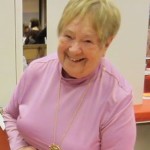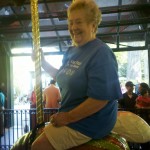So That’s What Cancer Looks Like
By Muriel J. Smith
 Editor’s note: This article is the second in an exclusive series of Muriel’s inspiring and hopeful message after dealing with breast cancer
Editor’s note: This article is the second in an exclusive series of Muriel’s inspiring and hopeful message after dealing with breast cancer
It was Nov. 25, two days after my 79th birthday, when Dr. Ann Hughes, the interpreting radiologist for the Star and Barry Tobias Women’s Health Center at Central State Medical Center, wrote to let me know my mammogram showed a finding “that requires additional imaging studies.” The radiologist sent the same information to Dr. Robert Pedowitz, my general practitioner, who immediately called me. He wanted me to see Dr. Mary Martucci, the medical director and surgical oncologist at the Women’s Center. I’m not saying it’s cancer, he cautioned, simply that he would like an oncologist involved right from the get go. Just in case.
A wise man, my GP, and the meeting with Dr. Martucci was set up almost immediately, giving me the opportunity to meet and talk with this kind, caring, and knowledgeable physician.
An ultrasound was scheduled for the first week of December, to be done by Dr. Kenneth Tomkovich, the interpreting radiologist. Dense breast tissue, the mammography had shown, common, not abnormal, but sometimes making it harder to find cancer on a mammogram.
The ultrasound was also done at the Women’s Center, with Dr. Tomkovich doing the procedure and positioning me, at my request so I could watch the probe entering my right breast on the ultrasound screen. It was quick, easy, painless, and over in a matter of minutes. I’m not a physician…barely even able to pronounce the medical terms. But on the screen I could see this funny-shaped little black blob at almost 12 o’clock in my right breast. I remember thinking, “so that’s what cancer looks like.” But I was neither in shock nor in fear. If it is, I reasoned, it’s small enough and visible enough to get it taken care of. Now. Before it got too big to handle. The radiologist confirmed it in a letter the next day; I had “an abnormality that requires a biopsy.”
The biopsy procedure was set for Dec. 17, As we had agreed, Dr. Martucci called me Dec. 18, as soon as the surgical pathology report was in. “I’m sure it’s cancer,” I had told her, “I don’t believe in coincidences, and there’s some reason why I read the ad about that discounted body massage.” No need to have me come in the office, I reasoned, “just give me a call.”
She did. And in her soft, yet firm, authoritative and knowledgeable voice, the surgical oncologist said, “well, the results are in, and you do have an invasive duct carcinoma.” It was Dec. 18. The doctor explained she wanted me to come in the office anyway, and discuss it further. The next day. I agreed.
Feelings of fear? I had none. I was grateful for that mammogram, perhaps a bit irked with myself I had not had one in four years. But I was confident this medical team of private physician, surgical oncologist and radiologist who had rallied around me so quickly knew what they were doing, wanted to get it done, and they would soon have me cancer free. I also knew there was a reason for all of this, and as a writer, I felt the reason was to spread the word about the importance of regular mammograms. I looked forward to seeing Dr. Martucci again.
The shock came when I went into the conference room at the Women’s Center…..I was beginning to enjoy the neat, cozy waiting room, the hot coffee and tea service, the friendly women at the reception desk. I laughed to myself at the two ‘abstract’ paintings on the wall; with all their squiggly lines and circular patterns they kind of looked like the ultrasound of my breast.
Dr. Martucci brought me into the conference room herself, but we weren’t alone. Seated were Dr. Tomkovich, the radiologist whom I had met at the biopsy, two of his nurses, Dr. Martucci’s nurse, and Melissa Olsen, another sweetheart of a gal whose title is “Cancer Navigator.”
Martucci, the surgical oncologist, took the lead. She read the formal surgical pathology report, the final diagnosis, the biopsy procedure which determined it and the clinical description of what was found and how. But then she put it into my language…she drew a picture and spelled out the meanings of all the words she had used…invasive…ductal…carcinoma….grade…HER2, lobules, ducts. I was feeling more at ease by the minute, and knowing somehow, she was a far better surgeon than she was an artist. Van Gogh and Manet could remain secure; Mary Martucci’s talent is in medicine and surgery!
When she finished, Dr. Martucci explained I had two options: she could put me under anesthesia, do a lumpectomy, meaning take the tumor out surgically, let me go home later the same day, and do some follow-up as needed.
Then she turned the lead over to Dr. Tomkovich. Not as warm and fuzzy as Dr. Martucci, but reassuring in his own self-confidence, Dr. Tomkovich launched into a clinical description of everything he could do. He explained he was involved in an investigational trial, the Women’s Center at CentraState was the only hospital in New Jersey involved, along with only 16 others in the nation. His procedure, he said, was called cryoablation, which meant simply smearing a bit of anesthesia on the area, inserting a needle, freezing the tumor, covering the puncture made with a band-aid, then sending me on my way. About 45 minutes, he estimated. And I come go about the rest of my day as planned. The trial had a specific audience: a woman had to be over 65, the tumor had to be invasive, and had to be less than 2 cm in size. I met all the criteria and would be an excellent candidate for the trial.
So that’s it! I said to myself. The reason for the cancer, for all the coincidences, for the discovery. I was meant to be a part of a trial and tell the world about it.
Although it only took me seconds to decide I’d rather have a needle insertion under a local numbing rather than a knife insertion and surgical removal under general anesthesia, both doctors wanted me to ask more questions, think it over, talk to my family, sleep on the decision. I did, and the next morning, my decision was still the same. Cryoablation would be the only way to go.
Like myself, my children were unafraid, excited I wanted to be part of a trial, and in agreement with my decision. No need to tell anyone else until the cryoablation was completed and the cancer was gone.
Regardless of which method I selected, the physicians and nurses explained, I would still go through the hospital’s protocol for procedures….a chest X-ray, blood work, EKG; later there would be meetings with a medical oncologist, a radiation physician, a bone density procedure. Centra State goes out of its way to ensure every precaution is taken to protect a woman’s health and her ability to undergo procedures safely. Melissa, ‘the cancer navigator,’ escorted me through the preliminary tests, and within an hour or so, I was ready for cryoablation.
Little did I know that in 47 days I would be cancer free.
Muriel J. Smith is a 55 year Monmouth County resident. A Freehold resident for the pasted 10 years, Muriel lived in Highlands for 40 years and spent 10 years traveling the country in a RV with her beloved husband Jimmy. She is an award winning reporter and was an editor of Forbes Magazine and The Courier. Widowed for the last 10 years, Muriel is the mother of four (one daughter deceased) a grandmother of 9 and great-grandmother of 6.












Muriel Smith is a class act and a writer I have enjoyed reading for 30 years. Her sense of humor is obviously still intact even after the medical scare. On her political reporting Muriel has always been thorough and fair. Maybe fearless is a word that might apply as well. I could never quite figure out whether Muriel leaned democrat or a republican as she has so many friends on both sides of the aisle. Perhaps Muriel rose above political labels is a just a practical, friendly, common sense patriotic American who likes to write and is good at it.
I think Doctor Martucci will be getting lots of calls after people read a cancer article that describes the process in an objective and not-so-scary way . Wish you well Muriel.
always a smart, good-natured, pleasant and informative lady! Best to you and yours!